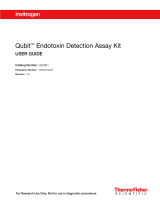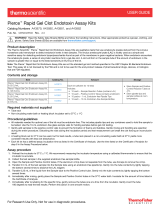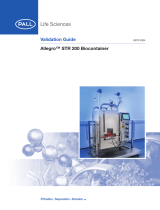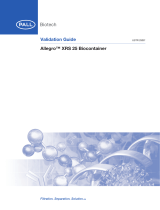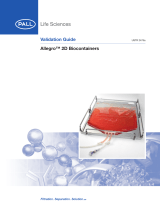Page is loading ...

INSTRUCTIONS
Pierce Biotechnology
PO Box 117
(815) 968-0747
Thermofisher.com
3747 N. Meridian Road
Rockford, lL 61105 USA
(815) 968-7316 fax
Number Description
88282 Pierce LAL Chromogenic Endotoxin Quantitation Kit, sufficient reagents to perform 50 assays of
standards and samples in a microplate (i.e., 50 wells total)
Kit Contents:
Escherichia coli (E. coli) Endotoxin Standard (011:B4), lyophilized, 1 vial,
15-40 endotoxin units (EU)/mL upon reconstitution
Limulus Amebocyte Lysate (LAL), lyophilized, 2 vials, 1.4mL/vial upon reconstitution
Chromogenic Substrate, lyophilized, 1 vial, 6.5mL/vial upon reconstitution
Endotoxin-free Water, 1 vial, 30mL
Storage: Upon receipt store at 4°C. Product shipped with an ice pack.
Introduction
The Thermo Scientific™ Pierce™ LAL Chromogenic Endotoxin Quantitation Kit is an efficient, quantitative endpoint assay
for the detection of gram-negative bacterial endotoxins. Bacterial endotoxin catalyzes the activation of a proenzyme in the
modified Limulus Amebocyte Lysate (LAL). The activated proenzyme then catalyzes the splitting of p-Nitroaniline (pNA)
from the colorless substrate, Ac-Ile-Glu-Ala-Arg-pNA; the activation rate is proportional to the sample endotoxin
concentration. After stopping the reaction, the released pNA is photometrically measured at 405-410nm. The correlation
between absorbance and endotoxin concentration is linear in the 0.1-1.0EU/mL range. The developed color intensity is
proportional to the amount of endotoxin present in the sample and can be calculated using a standard curve.
Important Product Information
• Accurate pipetting is critical for maintaining consistent results. A repetitive pipettor can aid in normalizing volumes
between samples. Ensure pipetting order and rate of reagent addition remain consistent from well to well and row to row.
• All materials (e.g., pipette tips, glass tubes, microcentrifuge tubes and disposable 96-well microplates) must be
endotoxin-free.
• Adjust the sample pH to 6-8 using endotoxin-free 0.1M NaOH or 0.1M HCl. Avoid pH-electrode contamination of the
sample by testing the pH of a small sample taken from the bulk sample.
• Components of undiluted serum interfere in the assay. Serum samples must be diluted 50- to 100-fold to be compatible.
The serum must be completely free of RBCs, and the diluted sample may need to be heat-shocked (70°C for 15 minutes).
• To stop all bacteriological activity, store samples to be tested at 2-8°C for <24 hours or -20°C for >24 hours.
• Maintaining the correct temperature is critical for reproducibility. Use a proper heating block at 37°C±1°C. Do not use a
cabinet-style incubator to perform the assay.
• Endotoxin adheres to glass and plastic surfaces; before pipetting, vortex solutions to ensure the correct endotoxin
concentrations are measured.
• Glass tubes are preferred for making standard stock solutions; however, polystyrene or polypropylene microcentrifuge
tubes (1.5mL) may also be used. When using microcentrifuge tubes, dedicate the bag of tubes for the assay and follow
aseptic techniques.
• If the test sample endotoxin concentration is >1.0EU/mL, dilute the sample five-fold in endotoxin-free water. Re-test.
Pub. No. MAN0016039
Rev B
.0
Pub. Part No. 2162445
88282
Pierce LAL Chromogenic Endotoxin
Quantitation K
it

Pierce Biotechnology
PO Box 117
(815) 968-0747
Thermofisher.com
3747 N. Meridian Road
Rockford, lL 61105 USA
(815) 968-7316 fax
2
• Assay inhibition occurs when substances in the test sample interfere with the LAL reaction. In the chromogenic assay,
this inhibition results in a lower final absorbance, indicating lower levels of endotoxin than what may be present in the
test sample. Determine the lack of product inhibition for each sample undiluted or at an appropriate dilution. See the
Additional Information Section for more details.
• Some LAL-reactive glucans (LRGs) may result in false positive signal in the LAL assay.1 In samples where LAL-
reactive glucans may be present, researchers may want to compare cellulase-treated samples to untreated samples to
determine contribution of signal resulting from LRGs.
• Samples turning yellow after addition of the Stop Reagent (25% acetic acid) or possessing significant initial color may
require special attention. See the Additional Information Section for more details.
• The kit reagents are “matched” to comply with Food and Drug Administration (FDA) requirements for endotoxin testing.
Each LAL lot is tested for functionality using the United States Reference Standard EC-6. The LAL lot is then matched
to a lot of our Control Standard Endotoxin (CSE) by testing in parallel with the Reference Standard Endotoxin (RSE).
The RSE/CSE correlation assay determines the potency of each CSE lot when used with each matching LAL lot.
Additional Materials Required
• Disposable endotoxin-free glass tubes or 1.5mL microcentrifuge tubes
• Disposable endotoxin-free pipette tips
• Disposable endotoxin-free 96-well microplates
• Heating block at 37°C±1°C
• Pipettor
• Repetitive pipettor (optional)
• Microplate reader
• 25% acetic acid (Stop Reagent)
Material Preparation
Note: Equilibrate all reagents to room temperature before use.
A. Endotoxin Standard Stock Solutions
1. Each E.coli Endotoxin Standard vial contains ~15-40EU of lyophilized endotoxin; the actual vial concentration is printed
on the label. Reconstitute by adding 1mL of room temperature endotoxin-free water to make Endotoxin Standard Stock.
For example, a vial with a concentration of 26EU, when reconstituted with 1.0mL of endotoxin-free water, will yield a
concentration of 26EU/mL. Vortex the solution vigorously for at least 15 minutes on a high speed vortex mixer before
use.
Note: Store lyophilized E.coli Endotoxin Standard at 2-8°C. Reconstituted stock solution is stable for 4 weeks at 2-8°C.
Prior to subsequent use, warm the solution to room temperature and vigorously mix for 15 minutes. (This is important
since the endotoxin adheres to sides of the glass vial.)
2. Prepare Standard Stock Solutions from the Endotoxin Standard Stock using the dilutions and procedures in Table 1.

Pierce Biotechnology
PO Box 117
(815) 968-0747
Thermofisher.com
3747 N. Meridian Road
Rockford, lL 61105 USA
(815) 968-7316 fax
3
Table 1. Dilutions and procedures for preparing Standard Stock Solutions.
Vial
Volume of Endotoxin
Standard Stock
(mL) Volume of vial A
(mL)
Endotoxin-free
Water
(mL)
Final endotoxin
concentration
(EU/mL)
A
0.05
–
(X-1)/20*
1.00
B
–
0.25
0.25
0.50
C
–
0.25
0.75
0.25
D
–
0.10
0.90
0.10
*X = endotoxin concentration of the E.coli Endotoxin Standard supplied with the kit; refer to the
Certificate of Analysis to get the lot-specific concentration.
A. Prepare a solution containing 1.0EU/mL of endotoxin standard by diluting 0.05mL of the
Endotoxin Standard Stock with [(X-1)/20]mL of endotoxin-free water, where X equals the
endotoxin concentration of the vial (e.g., if X= 26EU/mL, then dilute 0.05mL of this stock with
(26-1)/20, or 1.25mL, of endotoxin-free water). Vigorously vortex the solution for ≥1 minute
before proceeding.
B. Transfer 0.25mL of the 1.0EU/mL Standard vial A into a tube containing 0.25mL of endotoxin-
free water to prepare 0.5EU/mL Standard Stock Solution and vortex the solution vigorously
for 1 minute before use.
C. Transfer 0.25mL of 1.0EU/mL Standard vial A into a tube containing 0.75mL of endotoxin-free
water to prepare 0.25EU/mL Standard Stock Solution and vortex the solution vigorously for
1 minute before use.
D. Transfer 0.1mL of 1.0EU/mL Standard vial A into a tube containing 0.90mL of endotoxin-free
water to prepare 0.1EU/mL Standard Stock Solution and vortex the solution vigorously for
1 minute before use.
B. Limulus Amebocyte Lysate (LAL)
1. The LAL reagent contains lyophilized lysate prepared from the circulating amebocytes of the horseshoe crab Limulus
polyphemus. Reconstitute immediately before use with 1.4mL of endotoxin-free water and swirl gently to dissolve the
powder. If more than one vial is required, pool two or more vials before use. Avoid foaming; do not vortex the
solution.
Note: Store lyophilized LAL protected from light at 2-8°C. Reconstituted LAL reagent is stable for 1 week at -20°C or
colder if frozen immediately after reconstitution. Upon thawing, the reconstituted LAL may be used only one time; once
thawed, gently swirl the reagent to mix before adding to samples.
C. Chromogenic Substrate
1. Each vial contains ~7mg of lyophilized substrate. Reconstitute the Chromogenic Substrate by adding 6.5mL of
endotoxin-free water to yield a final concentration of ~2mM.
Note: Store lyophilized Chromogenic Substrate protected from light at 2-8°C. Reconstituted Chromogenic Substrate is
stable for 4 weeks when stored at 2-8°C. Prior to use, warm up sufficient substrate solution for the assay to
37°C±1°C.

Pierce Biotechnology
PO Box 117
(815) 968-0747
Thermofisher.com
3747 N. Meridian Road
Rockford, lL 61105 USA
(815) 968-7316 fax
4
Microplate Assay Procedure
Note: Equilibrate all reagents to room temperature before use.
1. Pre-equilibrate the microplate in a heating block for 10 minutes at 37°C±1°C.
Note: Do not use cabinet-style incubator to perform the test.
2. With the microplate maintained at 37°C±1°C, carefully dispense 50µL of each standard or unknown sample replicate
into the appropriate microplate well.
Note: Each series of determinations must include duplicate runs of a blank and the four endotoxin standards; the
blank contains 50µL of endotoxin-free water. If reaction inhibition is possible, see the Additional Information
Section.
3. At time T=0, add 50µL of LAL reagent to each well using a pipettor. Begin timing as the LAL is added. Once the LAL
has been added into all plate wells, briefly remove from the heating block and gently tap several times to facilitate
mixing. Cover the plate with the lid and return to heating block to incubate at 37°C±1°C for 10 minutes.
Note: Ensure pipetting order and rate of reagent addition remain consistent from well-to-well and row-to-row.
4. After exactly T=10 minutes, add 100µL of Chromogenic Substrate solution (prewarmed to 37°C±1°C) to each well.
Once the substrate solution has been added into all plate wells, briefly remove from the heating block and gently tap
several times to facilitate mixing. Cover the plate with lid and return to heating block to incubate the plate at 37°C±1°C
for 6 minutes.
Note: Pipette the substrate solution in the same manner as in step 3. Maintain a consistent pipetting speed.
5. At T=16 minutes, add 100µL of Stop Reagent (25% acetic acid). Once the stop reagent was added into all plate wells,
remove the plate from heating block and gently tap several times to facilitate mixing.
Note: Maintain the same pipetting order as in steps 3 and 4.
6. Measure the absorbance at 405-410nm on a plate reader.
7. Subtract the average absorbance of the blank replicates from the average absorbance of all individual standards and
unknown sample replicates to calculate mean ∆ absorbance.
8. Prepare a standard curve by plotting the average blank-corrected absorbance for each standard on the y-axis vs. the
corresponding endotoxin concentration in EU/mL on the x-axis. The coefficient of determination, r2, must be ≥0.98.
9. Use the formulated standard curve (linear regression) to determine the endotoxin concentration of each unknown sample
(Figure 1).
R² = 0.9991
0.0000
0.2000
0.4000
0.6000
0.8000
1.0000
1.2000
00.25 0.5 0.75 11.25
Net O.D. @ 405nm
EU/ml
Figure 1. Example standard curve for the quantitation of endotoxin in a
chromogenic assay.

Pierce Biotechnology
PO Box 117
(815) 968-0747
Thermofisher.com
3747 N. Meridian Road
Rockford, lL 61105 USA
(815) 968-7316 fax
5
Troubleshooting
Problem
Possible Cause
Solution
Non-linear standard curve
Standard Stock Solutions were not
mixed well
Vortex the Endotoxin Standard Stock for
15 minutes before each use.
Vortex all Standard Stock Solutions for 1 minute
before each use.
Pipetting order and rate of reagent
addition was irregular
Ensure pipetting order and rate of reagent addition
remain consistent from well to well and row to row.
Use a repetitive pipettor.
Incubation times were not followed
Strictly adhere to the incubation times.
Start the timer at the point of adding reagent into
the first well.
Higher absorbance in
blank than standards
Materials (e.g., tips, vials,
microplates) were contaminated
Use endotoxin-free materials.
Additional Information
A. Product Inhibition/Enhancement
Product inhibition occurs when substances in the test sample interfere with the LAL reaction. In the chromogenic assay, this
inhibition results in a lower, final absorbance, indicating lower levels of endotoxin than what may be present in the test
sample. Determine the lack of product inhibition for each sample undiluted or at an appropriate dilution.
To verify the lack of product inhibition, spike an aliquot or dilution of a test sample with a known amount of endotoxin (e.g.,
0.5EU/mL). Assay the spiked sample and the unspiked samples to determine the respective endotoxin concentrations. The
difference between the two calculated endotoxin values should equal the known concentration of the spike ±25%.
B. Example for Determination of a Non-inhibitory Dilution
Table 2. Example study for determining inhibition of a sample.
Sample
dilution
Spiked§
concentration
(EU/mL)
Unspiked
concentration
(EU/mL) Difference
1:10
0.28
0.18
0.10 = Inhibitory
1:20
0.36
0.11
0.25 = Inhibitory
1:40
0.50
< 0.1
0.50 = Non-inhibitory
§ Spiked concentrations should all show a value of 0.50EU/mL The values of
0.28 and 0.36 are indicative of inhibition at the respective dilutions.
Samples showing inhibition on the LAL reaction may require further dilution to overcome the inhibitory effects. Once the
non-inhibitory dilution is determined, the exact dilution can be found by testing two-fold dilutions near that dilution. The
degree of inhibition or enhancement is dependent on the product concentration.
Beta glucans are polymers of D-glucose found in fungi and plant cell walls with >1000-fold less LAL reactivity than
lipopolysaccharides. Inhibition and false-positive colors can occur in samples contaminated with beta glucans. Use
appropriate beta glucan blockers if any contamination is possible.

Pierce Biotechnology
PO Box 117
(815) 968-0747
Thermofisher.com
3747 N. Meridian Road
Rockford, lL 61105 USA
(815) 968-7316 fax
6
C. Colored Samples
In the chromogenic assay, samples turning yellow after addition of the Stop Reagent or possessing significant initial color
(e.g., tissue culture media) may require special attention. To determine if a sample’s intrinsic color will alter the absorbance
readings, construct a mock reaction tube by adding 50µL of sample, 150µL of endotoxin-free water and 50µL of Stop
Reagent with no incubation. Read the absorbance at 405-410nm. If the absorbance is significantly greater than the absorbance
of endotoxin-free water, then the intrinsic color will alter the correct sample absorbance readings. In such cases, include
appropriate controls in the assay.
Related Thermo Scientific Products
88270 Pierce High Capacity Endotoxin Removal Resin, 10mL
88271 Pierce High Capacity Endotoxin Removal Resin, 100mL
88272 Pierce High Capacity Endotoxin Removal Resin, 250mL
88273 Pierce High Capacity Endotoxin Removal Spin Column, 0.25mL, 5 columns
88274 Pierce High Capacity Endotoxin Removal Spin Column, 0.50mL, 5 columns
88276 Pierce High Capacity Endotoxin Removal Spin Column, 1mL, 5 columns
20339 Detoxi-Gel™ Endotoxin Removing Gel
20344 Detoxi-Gel Endotoxin Removing Columns
89896 Pierce Centrifuge Columns, 2mL, 25/pkg
89897 Pierce Centrifuge Columns, 5mL, 25/pkg
89898 Pierce Centrifuge Columns, 10mL, 25/pkg
23225 Pierce BCA Protein Assay Kit
22660 Pierce 660nm Protein Assay Kit
Reference
1Roslansky, P.F. and Novitsky, T.J. (2016). Sensitivity of Limulus amebocyte lysate (LAL) to LAL-reactive glucans. J Clin Microbiol 54 (5).
Jcm.asm.org/content/29/11/2477.short
This product (“Product”) is warranted to operate or perform substantially in conformance with published Product specifications in effect at the time of sale,
as set forth in the Product documentation, specifications and/or accompanying package inserts (“Documentation”) and to be free from defects in material and
workmanship. Unless otherwise expressly authorized in writing, Products are supplied for research use only. No claim of suitability for use in applications
regulated by FDA is made. The warranty provided herein is valid only when used by properly trained individuals. Unless otherwise stated in the
Documentation, this warranty is limited to one year from date of shipment when the Product is subjected to normal, proper and intended usage. This
warranty does not extend to anyone other than the original purchaser of the Product (“Buyer”).
No other warranties, express or implied, are granted, including without limitation, implied warranties of merchantability, fitness for any particular
purpose, or non infringement. Buyer’s exclusive remedy for non-conforming Products during the warranty period is limited to replacement of or
refund for the non-conforming Product(s).
There is no obligation to replace Products as the result of (i) accident, disaster or event of force majeure, (ii) misuse, fault or negligence of or by Buyer, (iii)
use of the Products in a manner for which they were not designed, or (iv) improper storage and handling of the Products.
Current product instructions are available at thermofisher.com. For a faxed copy, call 800-874-3723 or contact your local distributor.
© 2018 Thermo Fisher Scientific Inc. All rights reserved. Unless otherwise indicated, all trademarks are property of Thermo Fisher Scientific Inc. and its
subsidiaries. Printed in the USA.
/


